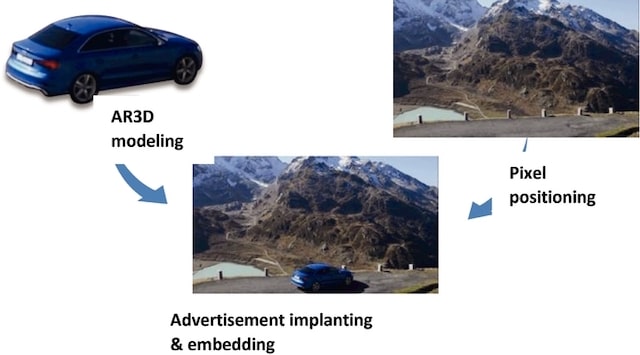WiMi Hologram Cloud Inc., a holographic augmented reality (AR) application platform in China, started trading under the ticker symbol of “WIMI” on NASDAQ on 1 April 2020.
WiMi priced its IPO of 4,750,000 American depositary shares (ADSs) at US$5.5 per ADS for a total of US$26.1 million dollars.
WiMi offers AR-based holographic services and products to cater to the customers’ needs. Currently, its offerings consist primarily of holographic AR advertising services (80.3% of total revenues in Q1 2020; 80.5% in 2018; and, 69.3% in 2017) and holographic AR entertainment products.
According to Frost & Sullivan, the total market size of China's holographic AR industry in terms of total revenues is expected to grow from RMB 3.6 billion in 2017 to RMB 454.8 billion in 2025.Click To TweetWiMi is the largest holographic AR application platform in China, in terms of the total revenue in 2018, according to Frost & Sullivan. It has built the most comprehensive and diversified holographic AR content library among all holographic AR solution providers in China.
It has developed the professional media player in China specifically designed for holographic AR contents. It has built in a comprehensive set of setting parameters and editing tools used for holographic AR content playback and allows end-users to playback complex high-fidelity simulations quickly and cost-effectively. End-users are able to adjust the contrast, saturation and vibrancy of the displayed holographic AR content and create their own custom visual effect.
Holographic AR Advertising Services
Currently, advertisement is the biggest vertical of AR. According to Frost & Sullivan, the market size was estimated at RMB1.5 billion in 2016, and is expected to be at RMB7.8 billion by 2020, with a compound annual growth rate (CAGR) of 71.6%, much higher than the growth of total online advertising market, which has a CAGR of 32.4% from 2014 to 2018.
In 2025, the market will be valued at RMB143.9 billion with a CAGR of 79.1%, indicating a larger market share in total online advertising market in the next five years.

WiMi’s holographic AR advertising software enables users to insert into video footages real or animated 3D objects that integrate seamlessly within the scene of such footages. Their online holographic AR advertising solution embeds holographic AR ads into films and shows that are hosted by leading online streaming platforms in China.
During Q1 2019, holographic AR ads produced using WiMi’s software generated a total of approximately 2.3 billion views, as compared to approximately 1.2 billion views during Q1 2018, representing an increase of 91.7%.
During Q1 2019, it had 65 customers, as compared to 49 customers during Q1 2018. The average revenue per customer was approximately RMB 1.0 million during Q1 2019, as compared to RMB 0.7 million during Q1 2018.
In 2018, WiMi had 121 customers, as compared to 97 customers in 2017. The average revenue per customer was approximately RMB 1.5 million in 2018, as compared to approximately RMB 1.4 million in 2017.
Through its proprietary image and video recognition technologies, its software enables users to analyze the underlying video footage at a pixel level to identify ad spaces that can be augmented by 3D objects.
Advertisers and their agencies purchase these ad spaces through application programming interface, or APIs, integrated with our systems, specifying their target audience and budgets and typically providing the 3D models to be embedded in the videos.
When the ad space is detected and 3D objects are generated, the 3D objects are embedded into the underlying streaming videos automatically on a batch-processing basis as determined by its software.
Holographic AR Entertainment Products
Entertainment, including gaming and video, takes a huge share of AR sector as well, and it is expected to have a higher growth rate. In 2016 the market size was estimated at RMB0.6 billion and is expected to be at RMB6.8 billion by 2020, with a CAGR of 83.5%.
AR entertainment is expected to have a market size of RMB180 billion by 2025, indicating a CAGR of 92.6%, and surpassing advertisement to be the biggest application scenario of AR.Click To TweetWiMi holographic AR entertainment products consist primarily of payment middleware software, game distribution platform, and holographic mixed reality (“MR”) software.
Payment middleware is a software solution that connects mobile apps to payment channels, giving mobile app users convenient access to a wide range of online payment options. WiMi has cooperated with more than 55 app developers and its payment middleware has been embedded to over 1,100 marketed mobile apps of over 300 customers in 2018, most of which were featured by AR functions.
Its mobile payment middleware facilitates app developers to build an in-app payment infrastructure that allows micropayments to be made or received through an efficient, secure system, without any interface redirection.
Such mobile payment middleware enables app developers to store users’ payment credentials in a trusted and safe environment and eases user’s burden of repeatedly entering and authenticating payment information for each transaction.
Its payment middleware can be fully integrated with various types of mobile apps, especially those employing AR technologies, such as live streaming, gaming, selfie, photo editing, and video-sharing apps. Currently, the payment middleware supports substantially all of the major online payment channels in China, and is compatible with the mainstream mobile operating systems.
Content Production
WiMi has built a comprehensive holographic AR content library. The formats of its holographic AR contents range from 3D models to holographic short videos.
As of December 31, 2018, it owned 4,654 ready-to-use AR holographic contents that were available to be adapted to its holographic AR products and solutions covering a wide category, including animals, cartoon characters, vehicles, and foods.
2,961 proprietary and licensed intellectual properties (“IP”) were for education scenarios, 851 for tourism, 739 for arts and entertainment and 103 for popular science.